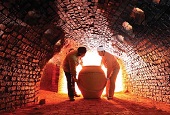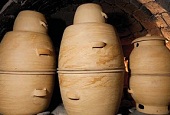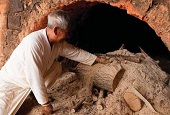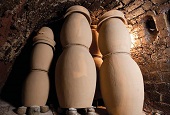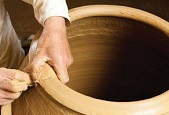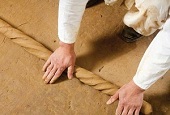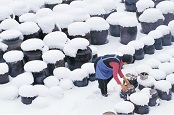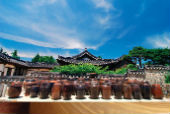View this article in another language
- 한국어
- English
- 日本語
- 中文
- العربية
- Español
- Français
- Deutsch
- Pусский
- Tiếng Việt
- Indonesian
This is the ninth part in our series, “Onggi, traditional earthenware vessel in Korea.”
Tools

Me & Garae (left)
The me is used to pound and to knead the clay.
The garae is used for cutting the clay.
Kkaeggi (center)
The kkaeggi is used to sieve out foreign substances from the clay.
Jjaljul (right)
The jjaljul is a tool for cutting the clay.

Dark sand and white soil (left)
These are used to prevent the unbaked pottery from sticking to one another when inside the kiln.
Storage jar for carving tools (center)
Traditional Korean pottery had little scratches and marks made with the carving tools. The carving tools were stored in water in a jar to keep them moist so that they would not stick to the clay.
Bangmangyi (right)
The bangmangyi is used to make the bottom of the urns. They are designed so as to not stick to the clay when being used.

Jeomgeomdae (left)
Jeomgeodae were used to measure the height and width of a piece of pottery.
Surae & Dogae (center)
Both the surae and the dogae are tools used to softly pound and to shape the sides of the urn. They each have a pattern carved into them, endowing their pattern onto the soft clay.
Geungae (right)
The geungae is used to trim the surface of the urn.

Gonggeure (left)
Gonggeure are used to trim the inside of the urn.
Budeorae (center)
The budeorae are braziers used to hold the charcoal that is placed inside the unbaked urns inside the kiln. They are used to keep the inside equally dry and to help the urn bake evenly on all sides.
Mulgajuk (right)
The mulgajuk is used to make the mouth of the urn.

Gasae knife (left)
Gasae knives are used to cut the clay. They are made of bamboo or pine.
Doreuraegi (center)
The doreuraegi is used to print patterns onto the soft unbaked clay.
Judungyikal (right)
The judungyikal is a type of knife, or spike, used to make earthenware kettle spouts.

Deulbo & Deulchae (left)
The deulbo and the deulchae are used to move around the unbaked urns. The cloth one is used for larger pots and the wooden one is used for smaller pieces of pottery.
Dokbaji (center)
The dokbaji is a set of wooden legs used to move the pottery projects.
Duite (right)
Duite are used to move the pottery.

Che (left)
The che is used to filter out foreign pollutants when making the glaze.
Che (center)
Another type of che is used when making the glaze.
Dokjul (right)
The dokjul supports the urn when the glaze is being applied.

Geokgangyi (left)
The geokgangyi is used to smooth the rim around the bottom of the urn once dried.
Gongdduggeong (center)
The gongdduggeong is a kind of lid used between the urns in the kiln so that they wouldn't stick together.
Changkal (right)
The changkal is used to take off the glaze that is stuck between the urns after firing in the kiln.
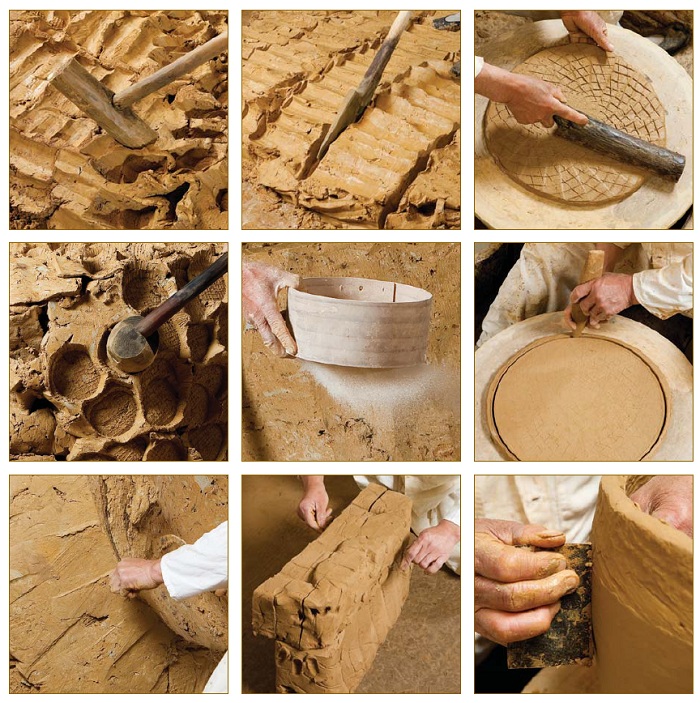
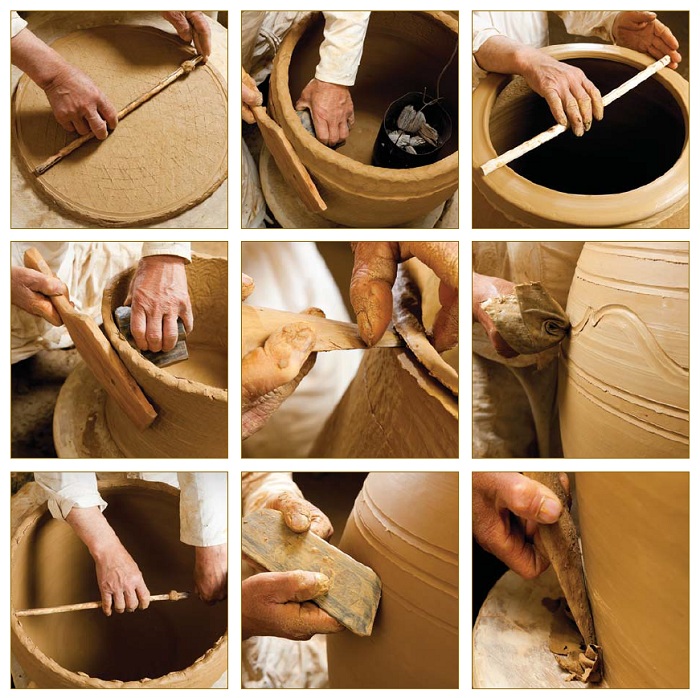
*This series of article has been made possible through the cooperation of the National Research Institute of Cultural Heritage. (Source: Intangible Cultural Heritage of Korea)
Tools

Me & Garae (left)
The me is used to pound and to knead the clay.
The garae is used for cutting the clay.
Kkaeggi (center)
The kkaeggi is used to sieve out foreign substances from the clay.
Jjaljul (right)
The jjaljul is a tool for cutting the clay.

Dark sand and white soil (left)
These are used to prevent the unbaked pottery from sticking to one another when inside the kiln.
Storage jar for carving tools (center)
Traditional Korean pottery had little scratches and marks made with the carving tools. The carving tools were stored in water in a jar to keep them moist so that they would not stick to the clay.
Bangmangyi (right)
The bangmangyi is used to make the bottom of the urns. They are designed so as to not stick to the clay when being used.

Jeomgeomdae (left)
Jeomgeodae were used to measure the height and width of a piece of pottery.
Surae & Dogae (center)
Both the surae and the dogae are tools used to softly pound and to shape the sides of the urn. They each have a pattern carved into them, endowing their pattern onto the soft clay.
Geungae (right)
The geungae is used to trim the surface of the urn.

Gonggeure (left)
Gonggeure are used to trim the inside of the urn.
Budeorae (center)
The budeorae are braziers used to hold the charcoal that is placed inside the unbaked urns inside the kiln. They are used to keep the inside equally dry and to help the urn bake evenly on all sides.
Mulgajuk (right)
The mulgajuk is used to make the mouth of the urn.

Gasae knife (left)
Gasae knives are used to cut the clay. They are made of bamboo or pine.
Doreuraegi (center)
The doreuraegi is used to print patterns onto the soft unbaked clay.
Judungyikal (right)
The judungyikal is a type of knife, or spike, used to make earthenware kettle spouts.

Deulbo & Deulchae (left)
The deulbo and the deulchae are used to move around the unbaked urns. The cloth one is used for larger pots and the wooden one is used for smaller pieces of pottery.
Dokbaji (center)
The dokbaji is a set of wooden legs used to move the pottery projects.
Duite (right)
Duite are used to move the pottery.

Che (left)
The che is used to filter out foreign pollutants when making the glaze.
Che (center)
Another type of che is used when making the glaze.
Dokjul (right)
The dokjul supports the urn when the glaze is being applied.

Geokgangyi (left)
The geokgangyi is used to smooth the rim around the bottom of the urn once dried.
Gongdduggeong (center)
The gongdduggeong is a kind of lid used between the urns in the kiln so that they wouldn't stick together.
Changkal (right)
The changkal is used to take off the glaze that is stuck between the urns after firing in the kiln.


*This series of article has been made possible through the cooperation of the National Research Institute of Cultural Heritage. (Source: Intangible Cultural Heritage of Korea)
